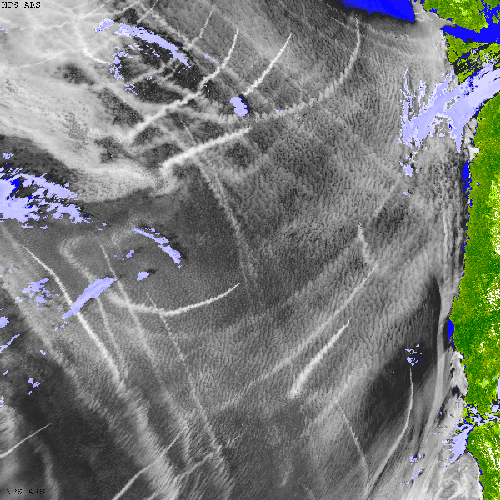Effects of contrails and ship tracks on climate
|
B. Geerts and E. Linacre |
2/’02 |
![]()
Contrails
 Contrails are
condensation trails produced by jet aircraft. In general, contrails form only
above about 8 km from the ground. Temperatures there in midlatitudes are less
than about -40° C. At such
temperatures, ice crystals form spontaneously when the saturation vapour
pressure (relative to ice) is reached, i.e vapour sublimates into ice without
the need of ice nuclei, such as dust particles.
Contrails are
condensation trails produced by jet aircraft. In general, contrails form only
above about 8 km from the ground. Temperatures there in midlatitudes are less
than about -40° C. At such
temperatures, ice crystals form spontaneously when the saturation vapour
pressure (relative to ice) is reached, i.e vapour sublimates into ice without
the need of ice nuclei, such as dust particles.
A topic of current public interest is whether contrails alter the Earth's radiation balance enough to affect surface temperatures. On the one hand, a reduction of the daytime maxima can be suspected by the enhanced reflection of sunshine into space. A reduction of solar irradiance at the surface by 3 to 5% (depending on the wavelength) has been measured at Lausanne, Switzerland, when the Sun passes trough a contrail (1). On the other hand, cirrus clouds have a warming effect on the global climate, because they trap more longwave radiation (emitted by the much warmer Earth surface) than they block incoming solar radiation. In other words, the sign of the regional climatic impact (cooling or warming) of contrails is uncertain.
The apparent reduction of the diurnal temperature range in the Midwestern USA during the last 50 years is partly attributed to the increase of contrails along the main flight corridors (2). Recently, in Utah, surface-based lidar and radiometric measurements were made of cirrus cloud created or triggered by jet engines (3). The contrails ranged from 13 km high at about -67°C, to 9 km at -42°C. Such temperatures imply that the droplets freeze spontaneously, i.e. without the need of nucleation. Once formed, the particles persist for minutes or hours, despite the air being far from saturated relative to liquid water. The Utah data indicate that the median ice crystal size of persisting contrails is smaller than that in typical cirrus clouds. If this is generally true, then the albedo cooling effect of contrails would outweigh the greenhouse warming effect, causing some (small) lowering of surface temperatures, especially in areas where the jet aircraft mainly fly during the daytime.
Ship tracks
The track of large ships is sometimes visualised by a trail of shallow stratus clouds. These clouds, known as 'ship tracks', form in the wake of ships and are remarkably long-lived (Fig 1). They typically are between 0.5-5 km wide, i.e. wide enough to be seen in visible satellite imagery. Sometimes a ship track appears as a band of enhanced cloud thickness embedded in stratus. Ship tracks are due to cloud condensation nuclei (CCN) in the ship's exhaust (4). They are most likely in a near-saturated environment that is otherwise depleted of CCN. Such environment is very common in the marine boundary layer over the subtropical highs. Over these large, quasi-stationary highs, the boundary-layer air is divergent, making it unlikely to draw in CCN-rich continental air.
The nature and climatic effect of ship tracks was investigated in a field campaign labeled MAST (Monterey Area ShipTrack), which was conducted during June 1994 off the central California coast. Ship tracks increase the albedo, yet have very little effect on the long-wave radiation balance, because they are so shallow. Therefore ship-tracks tend to cool the global climate, although the magnitude of this effect is likely to be small.

Fig 1. Enhanced multispectral satellite image of the Pacific Ocean off the west coast of North America on 21 June 1994. The land is shown in green, high cloud in light blue, and clear sky over cold water in deep blue.
References
- Mims, F.M. and D.J. Travis, 1997. Aircraft contrails reduce solar irriadiance. EOS, 78, Oct 14.
- Travis, D.J. and S.A. Changnon, 1997. Evidence of jet contrail influences on regional-scale diurnal temperature range. J. Weather Mod., 29, 74-83.
- Sassen, K., 1997.Contrail-cirrus and their potetial for regional climate change. Bull. Amer. Meteor. Soc 78, 1885-903.
- Ferek, R. J., D. A. Hegg, P. V. Hobbs, P. Durkee and K. Nielsen, 1998. Measurements of Ship-Induced Tracks in Clouds Off the Washington Coast. J. Geophys. Res., 103, 23,199-23,206.